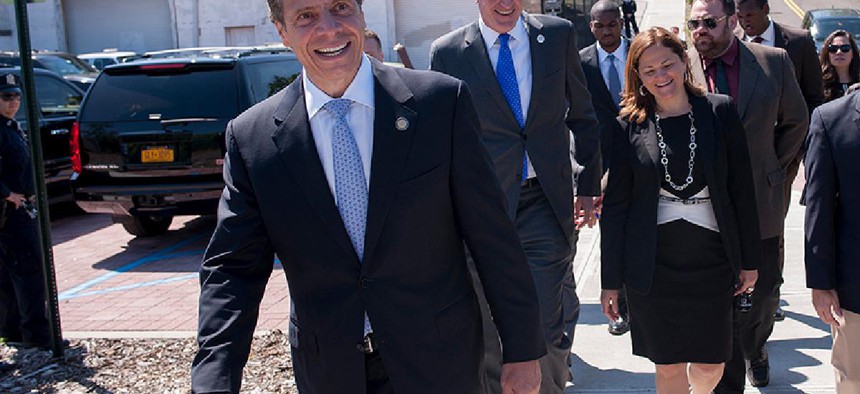In 2012, Donald Trump, a reality TV show host and real estate magnate, tweeted that President Barack Obama was “the least transparent President--ever--and he ran on transparency.” However, as President Trump, he has limited media access, refused to release his tax returns or the White House visitor logs, and frequently insulted reporters and media outlets. Trump isn’t the only New Yorker to change his tune on transparency once elected to office. Here are three elected officials whose records may not always match their promises.
RELATED: Why didn't Cuomo bring the fight to the GOP sooner?
Gov. Andrew Cuomo
What he said: In his 2010 campaign policy book, “Clean Up Albany,” then-gubernatorial candidate Cuomo outlined his commitment to transparency in government, saying that he would use technology “to make the state government the most transparent and accountable in history.” Separately, he promised during the campaign to post his schedules online, including meetings with officials and lobbyists.
What he’s done: Since taking office, the Cuomo administration tightened control over agency interactions with the press, and once implemented a policy of automatically deleting emails of state workers more than 90 days old. Cuomo does release daily schedules online, but they are often just notifications of what region the governor is in, and do not include information about his meetings or activities. His office does post more comprehensive schedules that include details on who he meets with, but those are delayed by months.
Cuomo also has not yet signed a bill supported by good government groups and passed in June that would reform the state Freedom of Information Lawby requiring that government agencies pay the attorneys' fees of petitioners seeking public information if the agency had no basis to deny a request. A spokesperson for the governor’s office said that this bill was under review.
Cuomo has avoided speaking regularly with members of the press except in controlled settings. He has not spoken in person with reporters in Albany since June, although a spokesperson for his office said that “he takes questions regularly from reporters in different parts of the state." Last week, he participated in two phone press conferences. At the second, a press call on the Republican tax plan on Thursday, reporters sat outside his office while he spoke. A spokesperson said that Cuomo was not at his office, but in his mansion when conducting this phone conference, and “wanted to spread the word on this critical, statewide issue.” Cuomo aides reportedly – and unsuccessfully – tried to plant favorable questions with reporters. He ended the phone call after four questions.
New York City Mayor Bill de Blasio
What he said: As public advocate, de Blasio issued a “Transparency Report Card” to city agencies to judge how well they responded to Freedom of Information requests. In a questionnaire from the New York City Bar Association, then-candidate de Blasio promised to “increase transparency” and said that he would disclose meetings with lobbyists.
What he’s done: In 2016, NY1 and the New York Post sued de Blasio for withholding emails from Jonathan Rosen, a communications consultant whom the administration deemed as an “agent of the city.” NY1 and the Post won their suit, but the mayor’s legal team is appealing the decision. The Village Voice reported in April that the mayor’s office takes an average of 66 days to respond to Freedom of Information requests from the public.
De Blasio and some aides were investigated by federal and state prosecutors for a pattern of providing favors for donors, but no criminal charges were brought against them. The mayor promised in 2016 that he would release a list of donors who did not receive favors. Instead, he published an op-ed in 2017 that did not list any specific donors.
De Blasio has had an often contentious relationship with the press. The mayor once accused city Comptroller Scott Stringer for conspiring with the New York Post “to create fake news.” He also walked out of a press conference earlier this year because reporters were asking off-topic questions.
RELATED: Mark-Viverito barred from speaking at street co-naming in the Bronx
New York City Council Speaker Melissa Mark-Viverito
What she said: Soon after she assumed her position as speaker, Mark-Viverito guided a sweeping reform bill for the Council bylaws to victory. In the press release originally announcing the bill, Mark-Viverito said it would “create a more responsive, transparent and inclusive legislative body.” Mark-Viverito also held roundtables with community and ethnic media reporters this month, and said that during her tenure she had made reaching out to these outlets “a council-wide standard.” Council spokesperson Robin Levine tweeted, “Now that’s expanding media access.”
What she’s done: Mark-Viverito has not always been transparent in negotiating legislation. In 2016, she prevented a vote on a package of two police reform bills, called the Right to Know Act, by quietly negotiating with the NYPD to have some reforms implemented, but not codified into city law. More recently, Mark-Viverito incurred the ire of City Hall reporters when she cordoned off parts of City Hall’s east wing that were previously open to reporters. After this move was blasted on social media, Levine “clarified our policies” to make sure that access would be allowed to this area once more.
Editor's note: This story has been updated with comments from the governor's office.


